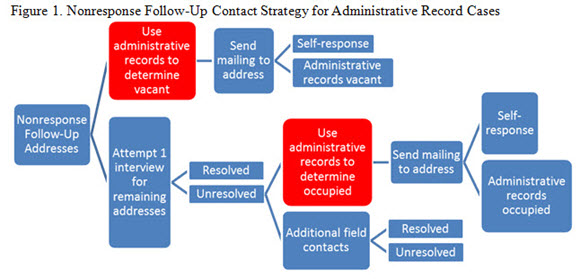Evaluating Possible Administrative Records Uses for the Decennial Census
Evaluating Possible Administrative Records Uses for the Decennial Census
When a household does not respond to the census, the U.S. Census Bureau must send a field worker to that address to complete a nonresponse follow-up interview. For the 2010 Census, 72 percent of American households mailed back a completed census form. The remaining 28 percent that did not respond by mail were counted via a census taker that visited their address. In-person interviews are much more costly than getting a response back in the mail. For the 2020 Census, the Census Bureau is researching the possible use of administrative records to provide a status and count for some addresses in the nonresponse follow-up universe—that is, to indicate whether the housing unit is likely to be occupied or vacant, and how many people may live in it. As outlined below, this information will aid in reducing the number of contacts during the nonresponse follow-up operation.
Over the last four years, the Census Bureau has tested various methods using administrative records to reduce the nonresponse follow-up workload. All tests used administrative records modeling with varying levels of complexity. In the tests, the administrative records allow us to split the nonresponse follow-up address universe into three categories: (1) units identified as administrative records occupied, (2) units identified as administrative records vacant, and (3) addresses identified as no determination.
The figure below shows the flowchart of the contact strategy related to administrative records cases for the nonresponse follow-up operation specific to the 2016 Census Test. When administrative records indicated that an addresses was vacant, it received no in-person visits during the nonresponse follow-up operation.
Addresses that the administrative records indicated to be occupied received only one visit in the 2016 Census Test. All units in the nonresponse follow-up address universe, whether the administrative records indicated they were vacant or occupied, did receive an additional postcard by mail during the nonresponse follow-up operation. The postcard told people at these addresses how to self-respond by filling out the questionnaire online or by responding through the questionnaire assistance line. In short, there are several ways before and during nonresponse follow-up that the Census Bureau is attempting to obtain and use self-responses before using administrative records determinations.
The development of possible administrative records models has been guided by comparing models retrospectively against 2010 Census results. Doing so provides a national evaluation of potential administrative records models. However, a difficulty underlying the evaluation of administrative records modeling usage is handling concerns such as undercounts and erroneous enumerations. Although the analysis using the 2010 Census results provides a solid basis for assessing model performance, it is not the only way to measure it.
To learn more about Nonresponse Follow-Up Contact Strategy for Administrative Record Cases, please join us at the Joint Statistical Meetings.




